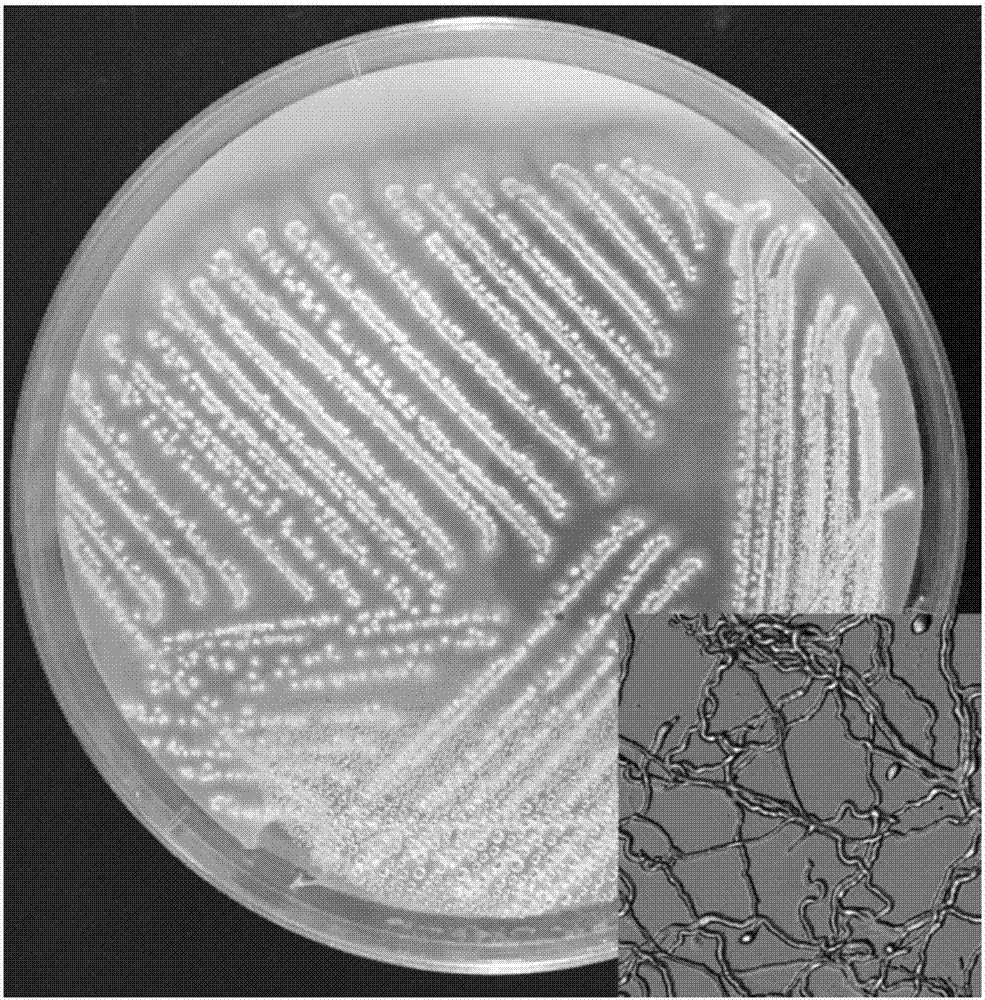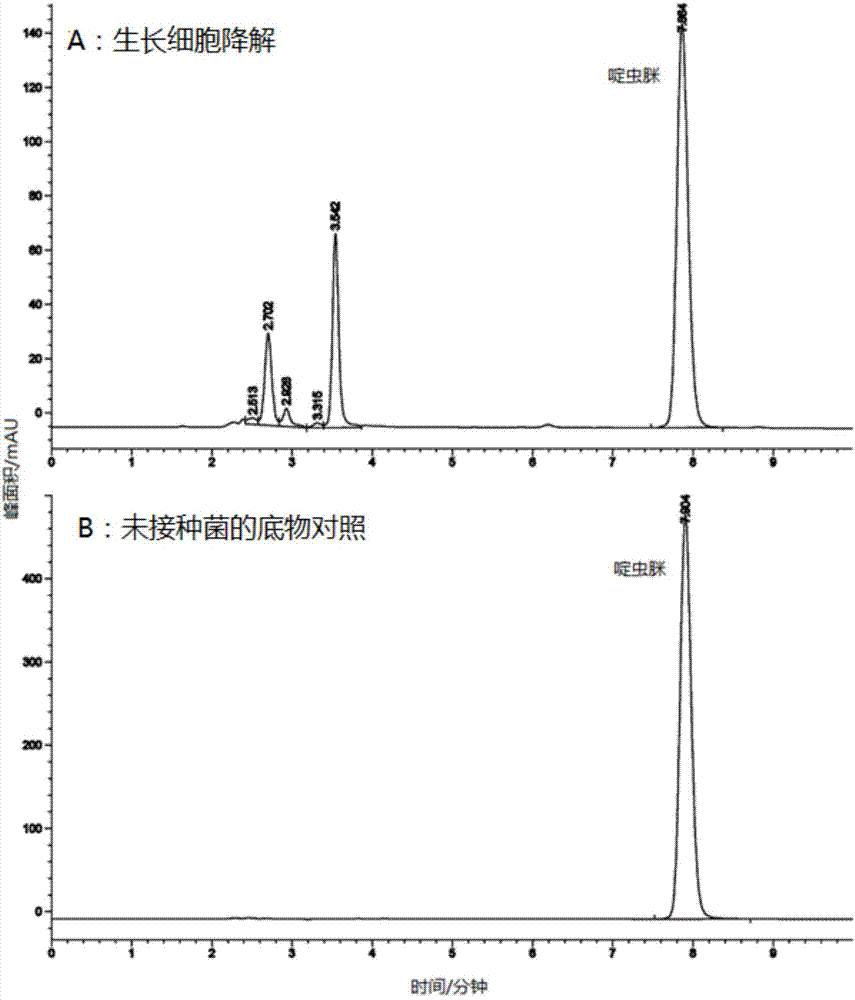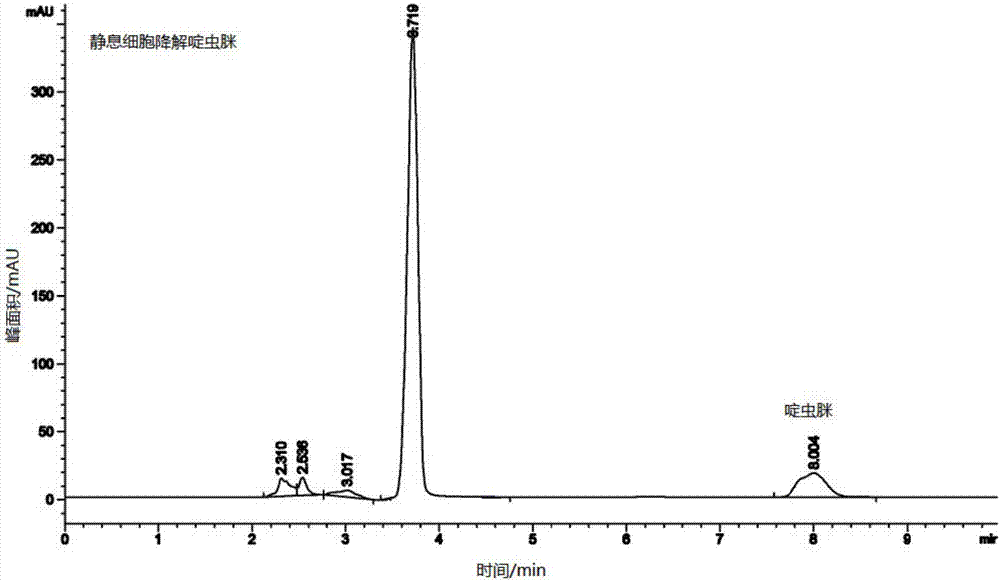Streptomyces canus and its application in degrading chloronicotinyl insecticide
A technique for neonicotinoid insecticides and Streptomyces griseus, which is applied in the field of Streptomyces fumigatus and its application in the degradation of neonicotinoid insecticides, achieving good application prospects
- Summary
- Abstract
- Description
- Claims
- Application Information
AI Technical Summary
Problems solved by technology
Method used
Image
Examples
Embodiment 1
[0020] Example 1: Isolation, Screening, Identification and Biological Characteristics of Biodegradable Acetamiprid Strain
[0021] 1. Bacteria isolation
[0022] Soil was collected from Xuzhou, Jiangsu, and 2 g of soil was added to 18 mL of sterile water containing glass beads, shaken for 2 hours, and after standing for 20 minutes, 100 μL of the sample was diluted to 10 -3 and 10 -4 After that, it was spread on a solid plate of mineral salt medium containing 50 mg / L acetamiprid. The composition of the mineral salt medium is (g / L): KH 2 PO 4 1.36, Na 2 HPO 4 2.13, MgSO 4 ·7H 2 O 0.5 and 10 mL metal ionic liquid, pH 7.0. The composition of metal ionic liquid is (g / L): CaCl 2 ·2H 2 O0.40,H 3 BO 3 0.30, CuSO 4 ·5H 2 O0.04, KI0.10, FeSO 4 ·7H 2 O0.20, MnSO 4 ·7H 2 O0.40, NaMoO 4 ·2H 2 0.20 and 10.0mL / L concentrated hydrochloric acid. The samples were cultured for 7 days in a shaker at 30°C with a rotational speed of 220 rpm, and the culture solution was spread ...
Embodiment 2
[0028] Example 2: Degradation of acetamiprid by growth cells of Streptomyces griseus CGMCC 13662
[0029]The preserved Streptomyces cinerea CGMCC 13662 was streaked on Gao's No. 1 solid medium, and cultured in a 30°C incubator until spores grew (about 7 days). The spores were collected with sterile water and a spore suspension was prepared, inoculated into a 500 mL Erlenmeyer flask containing 100 mL of ISP4 liquid medium (containing 200 mg / L acetamiprid), and cultured with shaking at 30° C. and 220 rpm. After culturing for 4 days, sampling was carried out for HPLC analysis, and the results showed that the acetamiprid content of the experimental group inoculated with Streptomyces grisea CGMCC 13662 was 0.26mmol / L (as shown in the appendix). figure 2 Shown in A); the acetamiprid content of the control group without inoculation was 0.94mmol / L (as shown in the appendix). figure 2 shown in B). The results showed that 73% acetamiprid could be degraded by the growth cell of Strep...
Embodiment 3
[0030] Example 3: Resting Cell Degradation of Acetamiprid by Streptomyces cinerea CGMCC 13662
[0031] The preserved Streptomyces cinerea CGMCC 13662 was streaked on Gao's No. 1 solid medium, and cultured in a 30°C incubator until spores grew. The spores were collected with sterile water and a spore suspension was prepared, inoculated into a 100 mL Erlenmeyer flask containing 30 mL of ISP4 liquid medium, and cultured with shaking at 30°C and 220 rpm. When the cells grow into mycelial balls, weigh 0.3 of the wet cells and wash them twice with 0.2 mol / L phosphate buffer (pH 7.5), then suspend them in 15 mL of the above-mentioned phosphate buffer (containing 200 mg / L of phosphate buffer). Acetamiprid) in a 50 mL centrifuge tube, then transferred to a 100 mL conical flask, and cultured at 30°C with shaking at 220 rpm for 96 h. HPLC analysis of the degradation of acetamiprid, as attached image 3 As shown, the results showed that acetamiprid was reduced by 0.47 mmol / L, and the de...
PUM
 Login to View More
Login to View More Abstract
Description
Claims
Application Information
 Login to View More
Login to View More - R&D
- Intellectual Property
- Life Sciences
- Materials
- Tech Scout
- Unparalleled Data Quality
- Higher Quality Content
- 60% Fewer Hallucinations
Browse by: Latest US Patents, China's latest patents, Technical Efficacy Thesaurus, Application Domain, Technology Topic, Popular Technical Reports.
© 2025 PatSnap. All rights reserved.Legal|Privacy policy|Modern Slavery Act Transparency Statement|Sitemap|About US| Contact US: help@patsnap.com



